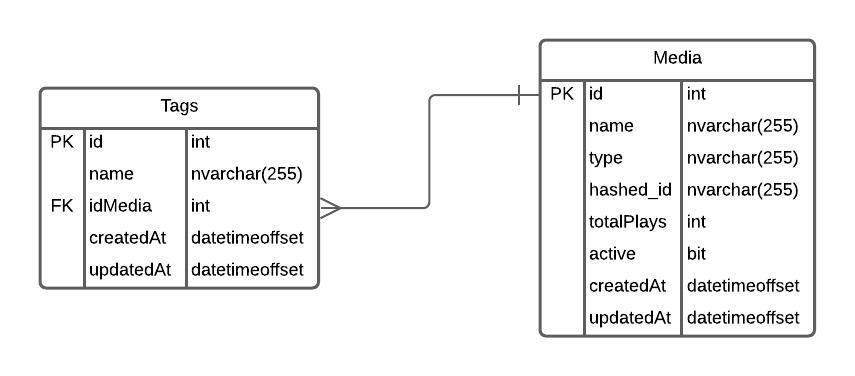The project was developed on macOS 11.3.1 ARM chip and Google Chrome Version 91.0.4472.106 (Official Build) (arm64).
Node version: v14.17.1
Client side utilized plain HTML/CSS/Vanilla.js.
Server side utilizes Nest.js, a Node.js framework, with Sequelize for an ORM connecting to an MSSQL instance in a Docker container. You can use any SQL language. Just input the env variable at /assignment/server/src/app.module.ts. If using a different SQL language, you will have to install the relevant drivers. For more information see: (https://docs.nestjs.com/techniques/database#database)
Methods implemented to accomplish features are available through current and newly made Prototype objects.
Here is an example of a send playing status method inside the existing Playlist object:
var Playlist = {
sendPlayingStatusToColumn: function(hashed_id, isPlaying) {
const tag = document.getElementById(hashed_id)
isPlaying ? tag.innerText = " - Playing" : isPlayingTag.innerHTML = ""
}
}
I used the "_all" matcher from the Wistia Javascript Player API to tap into the event callbacks and utilize the appropriate player methods to create a uniform playlist experience.
Embed links were leveraged to create a fluid playlist by setting playlistLinks=true to the first video.
document
.querySelector('.wistia_embed')
.classList.add('wistia_async_' + medias[0].hashed_id, 'playlistLinks=auto');
Referring back to the event driven behavior that the Wistia Javascript Player API support, I utilized the 'play', 'secondsChange', and 'end' callbacks to implement real-time features. You will notice the features involve sending info to be displayed on the video column from various sources or retrieving info from the video column to display on the embed area.
Playlist.sendPlayingStatusToColumn(hashed_id: string, isPlaying: boolean) is used to send is playing status to column.
Playlist.addCountDownBanner(nextVideo, currentVideo, second) retrieves thumbnail and title information from column via hashed_id lookup available video._playlist object.
In order the create a functional client-facing dashboard, it is needed to have a record of the historical state. I was not too sure of the solid use case of typical consumers. In this sample project, I noticed that retrieving the same videos from the Wistia API on the client load. It would be safe to assume that I should also have a record of these videos on my server so that I can track my metrics, and dictate the visibility of my video. I created a simple Media model with the basic metadata need to associate client-side data with my records. Hashed_id is key here. Server.seedMedia(medias) is a one-time method to populate the database.
The model in Nest.js:
@Table
export class Media extends Model {
@Column
name: string;
@Column
type: string;
@Column
hashed_id: string;
@Column({allowNull: false, defaultValue: 0})
totalPlays: number;
@Column({allowNull: false, defaultValue: true})
active: boolean
@HasMany(() => Tag)
tags: Tag[]
}
Media data from the server is loaded on page initialization along with the media data from the Wistia API. The historical data (totalPlays and visibility) from the server is attached to the media retrieved from the Wistia API.
async function() {
const serverMedias = await Server.findAllMedia()
Dashboard.getMedias().then(function(response) {
response.data.map(function(media) {
// Server.seedMedias(media)
const serverMedia = serverMedias.find( m => m.hashed_id === media.hashed_id)
const combinedMediaInfo = {...media, totalPlays: serverMedia.totalPlays, active: serverMedia.active }
Dashboard.renderMedia(combinedMediaInfo);
});
});
},
Notice the two liner:
const serverMedia = serverMedias.find( m => m.hashed_id === media.hashed_id)
const combinedMediaInfo = {...media, totalPlays: serverMedia.totalPlays, active: serverMedia.active }
Server.toggleMedia(event, isActive) is used to update Media.active column to true/false.
Similar to the dashboard, server data is loaded on page initialization. Server.filterActiveMedia(response.data) returns an array of active hashed_id confirmed by the server to filter the media to be rendered from the Wistia API.
Playlist.getMedias().then(async function(response) {
var medias = await Server.filterActiveMedia(response.data)
...
A simple findAll querying the database:
async findAllActiveMedia() {
return await this.mediaEntity.findAll({
where: { active: true }
})
}
SELECT COUNT(Media.[totalPlays]) From Media WHERE [Media].[totalPlays] > 1 will return the total number of videos that have been played at least once.
Schema for tag feature:
To pull up videos that are associated with a specific tag name. This is what the query would look like in sql server:
SELECT Media.* From Tags
INNER JOIN Media
ON idMedia = Media.[id]
WHERE Tags.[name] = 'My-tag1'
The INNER JOIN allows various rows to be associated as one linked record.
To find the video with the most number of tags:
SELECT TOP 1 mostTaggedMedias.[id], mostTaggedMedias.[name], mostTaggedMedias.[type], mostTaggedMedias.[hashed_id], mostTaggedMedias.[totalPlays], mostTaggedMedias.[active], COUNT(mostTaggedMedias.[id]) as 'tag_count'
FROM ( SELECT Media.*, Tags.[id] as 'idTag'
FROM Media
INNER JOIN Tags
ON Media.[id] = Tags.[idMedia]) mostTaggedMedias
GROUP BY mostTaggedMedias.[id], mostTaggedMedias.[name], mostTaggedMedias.[type], mostTaggedMedias.[hashed_id], mostTaggedMedias.[totalPlays], mostTaggedMedias.[active]
ORDER BY COUNT(mostTaggedMedias.[id]) DESC
I have done projects with little guardrails before so I appreciated the well-organized project in light of it being in plain Javascript. It speaks well of good design thinking. I strived to follow the same design pattern by making the code self-documenting.
It was very interesting getting to work with the Wistia Javascript Player API for the first time. I had to read a bit to understand the intended functionality of the Player API as well as the Embed Links. In the end, the '_all' matcher proved to be a very useful way to create a predictable video experience.
It is quite simple to plug in a backend of any language to start collecting basic metrics on media items. I would like to have the opportunity in the future to have a more fulsome developer experience of what the Wistia API is capable of in regards to creating virality for company brands.


